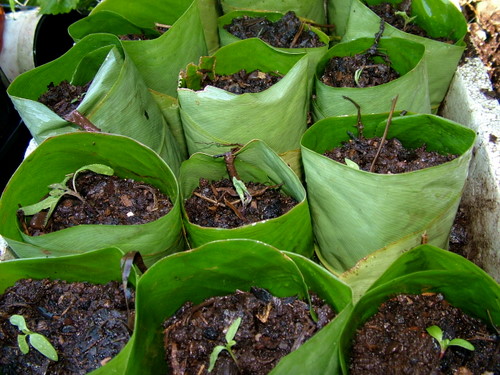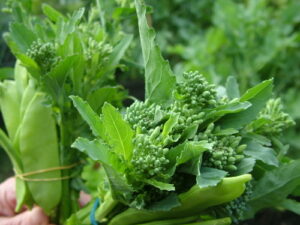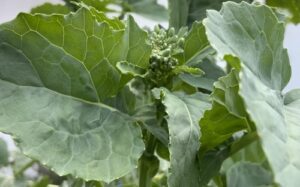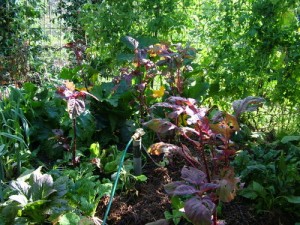Everything has lined up beautifully for a planting day today – no bottlenecks for once. I have old compost and creek sand for seed raising and potting mixes, seeds and seedlings for planting, a new bed just vacated by the chooks ready to plant into and mulch to mulch up the spaces in the old beds, a barrel of old seaweed brew, a dam full of water, a lovely cool, slightly overcast day following some good rain yesterday, and a Sunday free. When all the bits are there, the assembling is so easy, and I can feel like I get so much done in a day.
I have a seed germinating box full of tomato, capsicum, and eggplant seedlings planted last month, all now at the two leaf stage and ready to pot on. I have been selecting the strongest three or four of each and potting them in individual pots, and planting another round of seed of each to give me continuity of supply.
I also have seedlings of several varieties of beans, cucumbers, zucchini, and squash ready to plant out, and I’ll plant another round of all of them too, skipping the seed germinating stage and planting directly into individual pots.
 I have seedlings planted the month before now a good 15 cm tall and ready to plant out. I took the leaf-tube pot off to show you the root development. This seedling has had a month in its own private pot of compost mixed with a bit of creek sand. For the last week it has been out in full sun, and I can plant it out now without damaging the roots at all, and it won’t miss a beat.
I have seedlings planted the month before now a good 15 cm tall and ready to plant out. I took the leaf-tube pot off to show you the root development. This seedling has had a month in its own private pot of compost mixed with a bit of creek sand. For the last week it has been out in full sun, and I can plant it out now without damaging the roots at all, and it won’t miss a beat.
If I plant it into a newly chooked bed, I won’t need to fertilise any more at all. If I plant it into an older bed, I might give it an extra handful of compost and surround it with a good thick layer of mulch. It’s a Principe Borghese variety so it is indeterminate, so it will grow tall. I shall plant it next to a fence in one of my fortress fenced beds (one of the advantages to having to fence intensively is ready made trellises) and tie it up to the fence as it grows. I’ll water it in, but then only water if we get a few weeks without any rain. From now on, it’s pretty much on its own till it comes to picking.
And then, just because I can, I’m going to break all my own rules and plant some sweet corn seed directly out into the newly chooked bed. I didn’t have any seed to plant last month, so I’m a bit late with the corn, and now the bed is ready. I shall put some in pots as well at the same time, so I have some to fill any gaps from no-shows. I am aiming for about 16 plants – just about the minimum number I am likely to get away with to get a good rate of setting of kernels on the cobs. But I don’t want too many at once.
It’s just about the biggest planting day of the year, and it’s so nice when it all comes together without a bottleneck.




Love your leaf ‘jiffy pots’! Are those banana leaves? I didn’t read it anywhere in the post but maybe I am just blind… very clever anyways.
Good luck with the corn!
Hi dixibelle, yes I’m liking them too. They were an experiment last year and I’ve kept on using them. I vary my pots. Sometimes I use the old cut down 2 litre plastic milk bottles, but less and less these days. I also use banana bark and paper tubes, and sometimes just plastic pots. But these are my favourites lately.
I love reading about what you are doing in the garden. You really know what you are doing. I am determined to get good at gardening, but it is so hit and miss for me. Eg. this year the seeds came up beautifully but despite potting them on they look sad! I love your posts and thankyou for sharing your knowledge. I know I will get there in the end. Most of our yard has been taken over by vegies and each year is more successful than the last!
I wonder why they look sad? Light, water, nutrients – It sounds simple but getting the balance right! My shadehouse is a good resource. It lets in direct sunlight in the early morning, but shades the seedlings during the middle of the day. If they get too much sun too early they can dry out, but if they don’t get enough, they go leggy and prone to disease. Water – as I pot up seedlings, I soak them in a weak seaweed solution to bed them in. After that, again the shadehouse is good. It helps keep them moist but not too wet. I also use a potting mix that is 50% creek sand for drainage. And nutrients. Old compost in the potting mix, weak seaweed solution for the first watering, and occasionally after especially if they are in pots for a long time. Bit of wood ash in the potting mix for peas and beans coz they like it a bit more alkali. Prick out carefully (I use a kitchen fork) and pot them on early so as not to damage the roots. You’ll get the hang of it, and once you’ve found the system that works for you, you just stick with it. Good luck!
Love your leaf pots, Linda! Could you please clarify for me once and for all what determinate and indeterminate tomatoes means? I knew once, but keep forgetting! I know it doesn’t actually have anything to do with determination or bloody-mindedness! 🙂
Hi Celia, gardening jargon. Technically it refers to whether the plant has a determinate or final bud or not. Determinate tomatoes stop growing once they have set fruit, so the plant is shorter, bears earlier, and all the fruit is harvested at once over a short period. Indeterminate tomatoes keep growing after they’ve set their first fruit. They’re also known as vine tomatoes, because they do grow like a vine. They can be very tall and need to climb something. They set fruit over a long time. If frost doesn’t kill them, they will keep producing for months. Older and wilder tomatoes tend to be indeterminate – that’s the natural habit of the plant. Determinate tomatoes have been bred to be more suitable for producing for a market.
Thanks Linda, that makes sense. I don’t think we grow any determinate varieties…
I love your idea of using leaves for starter pots. So clever. I’m trying to think of what I might find locally to use that way and will be keeping an eye out. Thanks for sharing your gardening skills. Oh, and cooking skills. You have the most interesting breakfasts.
My cholesterol is a bit up there, though my “ratio of good to bad” is fine. No way am I going to take the drugs. Though eggs have cholesterol, the yolks are loaded with lecithin which helps against plaque build up. Also, cholesterol isn’t as bad evil as it’s made out to be. A bigger issue is inflammation. Some anti-inflammatory foods are fresh pineapple, garlic, onions, celery, salmon. Maybe stuff you’ve already studied, but just sharing, in case.
brenda from arkansas
Thanks Brenda. My cholesterol ratio is good too, so I’m not really concerned. I think it is genetic. But it’s an interesting challenge in any case. Fresh turmeric tea – just a slice of fresh turmeric with boiling water – is also really nice, and anti-inflammatory. Just trying to think how far north Arkansas is, whether it would be sub-tropical enough for turmeric?
Arkansas – zone 6, around 35 degrees north, so tropicals come inside during the winter. I never thought of growing turmeric – you grow it? I want to try that, but I don’t recall ever seeing it in a seed catalog. This is exciting. Must see what I can find out about this. :))
brenda from arkansas
Hi Brenda, yep, I grow turmeric. It’s a great crop, though I don’t know that it will survive in your climate. I’ve written a post about it here. If you were closer I’d send you a root to try!
Pingback:Fruiting Planting Days in Mid Spring – the Sweet Corn Goes In